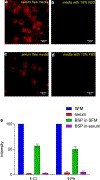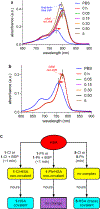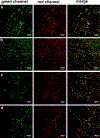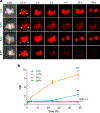Role of Albumin in Accumulation and Persistence of Tumor-Seeking Cyanine Dyes
- PMID: 31909595
- PMCID: PMC7174984
- DOI: 10.1021/acs.bioconjchem.9b00771
Role of Albumin in Accumulation and Persistence of Tumor-Seeking Cyanine Dyes
Abstract
Some heptamethine cyanine dyes accumulate in solid tumors in vivo and persist there for several days. The reasons why they accumulate and persist in tumors were incompletely defined, but explanations based on uptake into cancer cells via organic anion transporting polypeptides (OATPs) have been widely discussed. All cyanine-based "tumor-seeking dyes" have a chloride centrally placed on the heptamethine bridge (a "meso-chloride"). We were intrigued and perplexed by the correlation between this particular functional group and tumor uptake, so the following study was designed. It features four dyes (1-Cl, 1-Ph, 5-Cl, and 5-Ph) with complementary properties. Dye 1-Cl is otherwise known as MHI-148, and 1-Ph is a close analog wherein the meso-chloride has been replaced by a phenyl group. Data presented here shows that both 1-Cl and 1-Ph form noncovalent adducts with albumin, but only 1-Cl can form a covalent one. Both dyes 5-Cl and 5-Ph have a methylene (CH2) unit replaced by a dimethylammonium functionality (N+Me2). Data presented here shows that both these dyes 5 do not form tight noncovalent adducts with albumin, and only 5-Cl can form a covalent one (though much more slowly than 1-Cl). In tissue culture experiments, uptake of dyes 1 is more impacted by the albumin in the media than by the pan-OATP uptake inhibitor (BSP) that has been used to connect uptake of tumor-seeking dyes in vivo with the OATPs. Uptake of 1-Cl in media containing fluorescein-labeled albumin gave a high degree of colocalization of intracellular fluorescence. No evidence was found for the involvement of OATPs in uptake of the dyes into cells in media containing albumin. In an in vivo tumor model, only the two dyes that can form albumin adducts (1-Cl and 5-Cl) gave intratumor fluorescence that persisted long enough to be clearly discerned over the background (∼4 h); this fluorescence was still observed at 48 h. Tumors could be imaged with a higher contrast if 5-Cl is used instead of 1-Cl, because 5-Cl is cleared more rapidly from healthy tissues. Overall, the evidence is consistent with in vitro and in vivo results and indicates that the two dyes in the test series that accumulate in tumors and persist there (1-Cl and 5-Cl, true tumor-seeking dyes) do so as covalent albumin adducts trapped in tumor tissue via uptake by some cancer cells and via the enhanced permeability and retention (EPR) effect.
Conflict of interest statement
The authors declare no competing financial interest.
Figures






Similar articles
-
On the Mechanisms of Uptake of Tumor-Seeking Cyanine Dyes.Bioconjug Chem. 2018 Nov 21;29(11):3886-3895. doi: 10.1021/acs.bioconjchem.8b00708. Epub 2018 Oct 24. Bioconjug Chem. 2018. PMID: 30354072
-
Hows and Whys of Tumor-Seeking Dyes.Acc Chem Res. 2021 May 4;54(9):2121-2131. doi: 10.1021/acs.accounts.0c00733. Epub 2021 Apr 20. Acc Chem Res. 2021. PMID: 33877807 Review.
-
Albumin-seeking dyes with adjustable assemblies in situ enable programmable imaging windows and targeting tumor imaging.Theranostics. 2024 Apr 15;14(7):2675-2686. doi: 10.7150/thno.92991. eCollection 2024. Theranostics. 2024. PMID: 38773981 Free PMC article.
-
Cytotoxicities of Tumor-Seeking Dyes: Impact on Future Clinical Trials.ChemMedChem. 2023 Mar 1;18(5):e202200561. doi: 10.1002/cmdc.202200561. Epub 2023 Jan 26. ChemMedChem. 2023. PMID: 36630600 Free PMC article.
-
Site-specific albumin tagging with chloride-containing near-infrared cyanine dyes: molecular engineering, mechanism, and imaging applications.Chem Commun (Camb). 2023 Nov 2;59(88):13125-13138. doi: 10.1039/d3cc04200f. Chem Commun (Camb). 2023. PMID: 37850230 Review.
Cited by
-
Unveiling role of serum albumin in disaggregation and cellular delivery of a near-infrared chlorophyll-based photosensitizer in breast cancer cells.Photochem Photobiol Sci. 2025 Jul 21. doi: 10.1007/s43630-025-00764-1. Online ahead of print. Photochem Photobiol Sci. 2025. PMID: 40690194
-
Multifunctional Near-Infrared Dye IR-817 Encapsulated in Albumin Nanoparticles for Enhanced Imaging and Photothermal Therapy in Melanoma.Int J Nanomedicine. 2023 Sep 4;18:4949-4967. doi: 10.2147/IJN.S425013. eCollection 2023. Int J Nanomedicine. 2023. PMID: 37693889 Free PMC article.
-
Ready vascular permeability of a near-infrared fluorescent agent ASP5354 for intraoperative ureteral identification enables imaging of carcinoma tissues.Sci Rep. 2023 Jun 17;13(1):9832. doi: 10.1038/s41598-023-37025-z. Sci Rep. 2023. PMID: 37330535 Free PMC article.
-
Structure-Inherent Tumor-Targeted IR-783 for Near-Infrared Fluorescence-Guided Photothermal Therapy.Int J Mol Sci. 2024 May 13;25(10):5309. doi: 10.3390/ijms25105309. Int J Mol Sci. 2024. PMID: 38791347 Free PMC article.
-
Comparison of Five Near-Infrared Fluorescent Folate Conjugates in an Ovarian Cancer Model.Mol Imaging Biol. 2023 Feb;25(1):144-155. doi: 10.1007/s11307-021-01685-y. Epub 2021 Dec 10. Mol Imaging Biol. 2023. PMID: 34888759 Free PMC article.
References
-
- van Tellingen O, Yetkin-Arik B, de Gooijer MC, Wesseling P, Wurdinger T, and de Vries HE (2015) Overcoming the blood-brain tumor barrier for effective glioblastoma treatment. Drug Resist. Updates 19, 1–12. - PubMed
-
- Lv Q, Yang X, Wang M, Yang J, Qin Z, Kan Q, Zhang H, Wang Y, Wang D, and He Z (2018) Mitochondria-targeted prostate cancer therapy using a near-infrared fluorescence dye-monoamine oxidase A inhibitor conjugate. J. Controlled Release 279, 234–242. - PubMed
-
- Lv Q, Wang D, Yang Z, Yang J, Zhang R, Yang X, Wang M, and Wang Y (2019) Repurposing antitubercular agent isoniazid for treatment of prostate cancer. Biomater. Sci 7, 296–306. - PubMed
Publication types
MeSH terms
Substances
Grants and funding
LinkOut - more resources
Full Text Sources
Other Literature Sources
Medical

